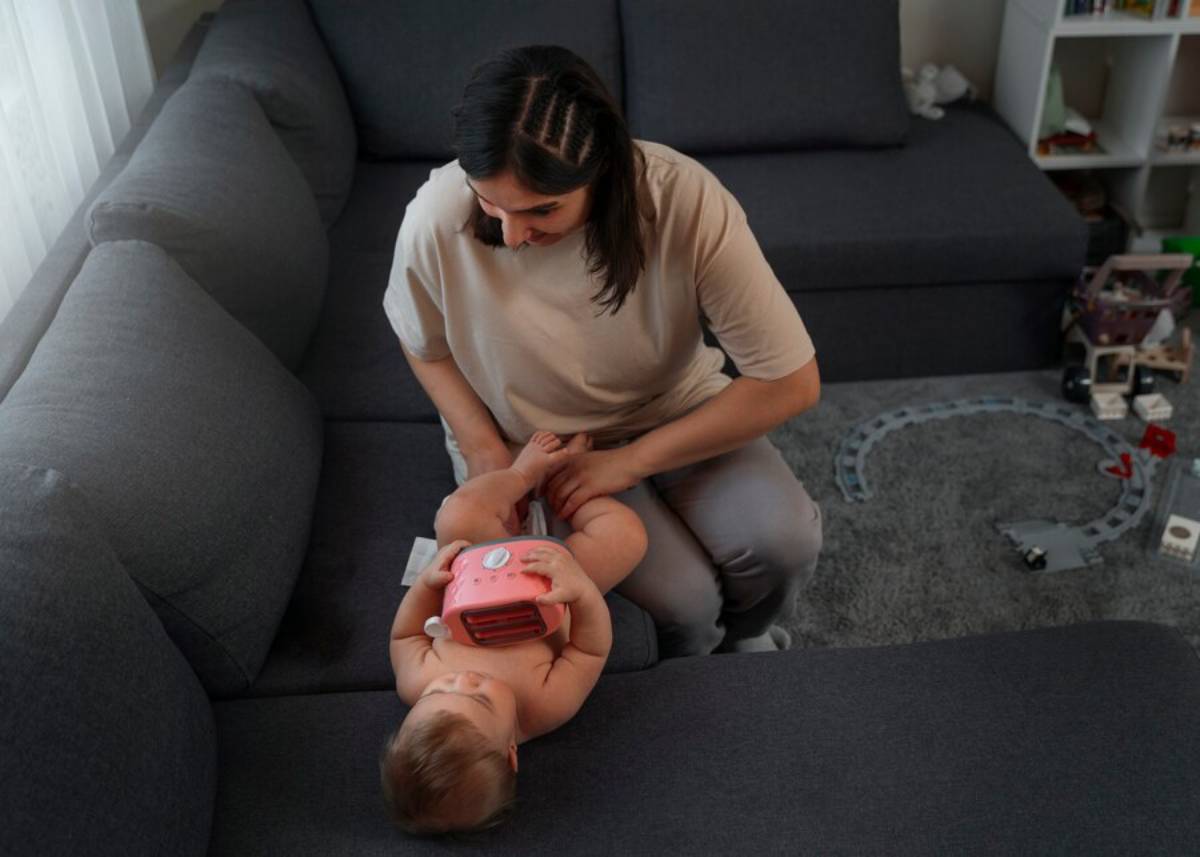The Parenting & Family Blog

Calming Techniques for Babies with Colic
Understanding Colic and its Impact
Having a baby is exciting, but it can be tough, too—especially with colic. Colic is a common condition in newborns. It makes them cry a lot and often feel inconsolable. Seeing your baby upset for no clear reason can be really frustrating and tiring for parents.
Colic usually starts in the first few weeks of life. It can last for several months. The exact cause of colic is still debated. However, many think it relates to digestive issues, gas, or an immature nervous system. Colicky babies can cry for over three hours each day, three days a week, for three weeks or longer. This makes it one of the toughest times for new parents.
In this blog post, we’ll explore effective calming techniques for babies with colic. We’ll offer parents various ways to soothe their baby’s discomfort. From easy methods to lifestyle changes, our solutions will help bring peace back to the home. The goal is to support parents and their babies through this tough time. We provide compassion and practical tips to help them.
What is Colic?
The Basics of Colic
Colic is a term used to describe excessive crying and fussiness in babies. It often occurs during the first few months of life. It typically starts around 2 to 3 weeks of age and tends to peak around 6 to 8 weeks. Colic can cause emotional distress for both babies and parents. However, it doesn’t mean parents are doing a bad job or that there is a serious medical problem. Most babies with colic are otherwise healthy.
While the exact cause of colic remains unclear, there are several theories, including:
- Immature digestive system: Some experts believe colic may be tied to a baby’s developing digestive system. This system might struggle to process food properly.
- Gas and bloating: Excessive gas can cause discomfort, making babies cry.
- Overstimulation: Babies can be very sensitive to their surroundings. Too much sensory input may cause them to cry.
- Food sensitivities or allergies: This can also cause colic. For example, some babies may react poorly to dairy products.
How to Recognise Colic
Parents should spot colic signs. This helps tell it apart from other reasons for crying, like hunger, tiredness, or illness. The key characteristics of colic include:
- Crying that starts in the late afternoon or evening, often for no apparent reason.
- Intense crying episodes that last at least three hours a day.
- Crying is difficult to soothe, even with feeding or comfort.
- The baby might show clenched fists, pull their legs to their tummy, and arch their back.
The Emotional Toll on Parents
Dealing with a baby who has colic can be emotionally exhausting. The incessant crying can leave parents feeling helpless, frustrated, and sometimes overwhelmed. Understanding calming techniques can help both the baby and the parents find relief.
Effective Colic Relief Techniques
There is no one-size-fits-all solution for colic, as each baby is unique. Many parents have found ways to soothe their babies during this challenging time.

1. Gentle Baby Massage
Gentle baby massage can have a calming effect on both the baby and the parent. It can help ease digestive discomfort, reduce gas, and promote relaxation. Use a soothing lotion or baby oil and gently massage your baby’s tummy in a clockwise motion. This can help relieve trapped gas and promote smoother digestion.
- How to do it: Place your baby on their back. Then, gently press with your fingertips to make small circles on their tummy.
- Benefits: Relieves gas, boosts circulation, and soothes babies with colic pain.
2. Swaddling
Swaddling is a timeless method. It feels like the cosy warmth of the womb. Wrapping your baby in a soft blanket can help them feel secure. It can also reduce reflexes that might cause distress.
- How to do it: Use a breathable, soft blanket to wrap your baby snugly, leaving enough room for their hips to move.
- Benefits: Helps babies feel safe and reduces startling movements. This can calm crying spells.
3. Holding Your Baby in the ‘Colic Hold’
The colic hold, or ‘fussiness hold,’ helps ease your baby’s discomfort. You hold your baby in a special way to achieve this. This technique can help babies pass gas more easily and calm down.
- How to do it: Lay your baby on their tummy, with their head resting on your arm and their body supported by your hand. Gently rock them back and forth.
- Benefits: Relieves gas and helps calm babies who are experiencing abdominal discomfort.
4. White Noise or Soothing Sounds
Sometimes, colic can be exacerbated by overstimulation. Soothing sounds can block out noise and calm the baby’s nervous system. Many babies respond well to white noise, which mimics the sounds they hear while in the womb.
- How to do it: To help your baby, play white noise, soft music, or heartbeat sounds. Make sure they are in a comfy position.
- Benefits: Helps babies relax by providing a familiar, consistent sound.
5. Feeding Adjustments
If you think your baby’s colic is due to gas or tummy troubles, try changing their feeding routine. Consider the type of formula or breast milk you use. Also, think about how often you feed and the feeding positions.
- Formula Feeding: If you bottle-feed, consider using a colic-friendly formula. It helps reduce gas and discomfort.
- Breastfeeding: If you breastfeed, track your diet. This can help find food sensitivities, like dairy or caffeine, that may affect your baby.
- Feeding positions: Hold your baby upright while feeding. This helps reduce the air they swallow.
6. Bicycle Legs
Bicycle legs exercise is a simple way to relieve gas and calm colicky babies. It mimics the movement of cycling, which can help release trapped air and ease discomfort.
- How to do it: Gently move your baby’s legs in a bicycle motion while they are on their back. This can help them pass gas and relieve pressure on their tummy.
- Benefits: Helps release trapped air and can provide relief from bloating and discomfort.

7. Bath Time for Relaxation
A warm bath can be a great way to calm a colicky baby. Warm water and gentle massage can soothe your baby. They help relax muscles and ease discomfort.
- How to do it: Fill a baby tub with warm water (not too hot), and place your baby in the water. Gently massage their back, neck, and tummy.
- Benefits: Warm water helps your baby relax and eases tension in their body.
8. Movement and Rocking
Many babies with colic respond well to gentle rocking or movement. Whether in a rocking chair, baby swing, or stroller, the motion can soothe your baby and help calm their crying.
- How to do it: Gently rock your baby back and forth in your arms or a safe rocking chair.
- Benefits: The rhythmic motion feels like what babies felt in the womb. This helps create a calming effect.

Creating a Colic-Friendly Environment
Soothing techniques can give quick relief. But longer-term lifestyle changes can also help manage colic. The space you set up for your baby matters a lot for their comfort.
1. Maintain a Calm Environment
Colicky babies can get overstimulated. Loud noises, bright lights, or too much activity can trigger this. Make a calming space. Dim the lights. Cut down on noise. Keep things peaceful.
- How to do it: Keep your home quiet, use soft lighting, and avoid overwhelming your baby with too many visitors or sensory stimulation.
- Benefits: A calm environment can reduce crying episodes and help your baby relax more easily.
2. Set a Routine
Babies thrive on routine. Having a predictable schedule can help reduce anxiety and make them feel secure. Try to establish regular feeding, sleeping, and play times, and stick to them as much as possible.
- How to do it: Develop a consistent daily schedule with regular feeding and nap times.
- Benefits: A predictable routine helps babies feel secure, which can reduce fussiness and crying.
3. Ensure Proper Sleep
Sleep deprivation can contribute to a baby’s irritability. It is essential to ensure that your baby is getting enough rest. A well-rested baby is more likely to be calm and content throughout the day.
- How to do it: Establish a calming bedtime routine that helps your baby unwind, such as a warm bath or a gentle lullaby.
- Benefits: Proper sleep helps babies feel refreshed and reduces the likelihood of excessive crying.
When to Seek Medical Advice
Colic often goes away on its own, but sometimes you need to see a doctor. If your baby cries and has symptoms like vomiting, fever, or changes in eating, it could mean a serious issue. If you’re worried about your baby’s health, talk to a healthcare professional. Also, seek help if colic symptoms last more than 3-4 months.
Conclusion: Finding Relief for Both Baby and Parent
Caring for a colicky baby can feel tough. Yet, with some patience and the right methods, you can help ease their discomfort. This will bring calm back to your home. You can soothe your baby’s crying in many ways. Try gentle massage, rocking, or adjusting feeding routines. Colic is temporary. With the right support, you and your baby can get through this tough time.
If you’re a parent dealing with colic, reach out. Talk to other parents, health pros, or online groups for support. You’re not alone in this journey, and with a bit of trial and error, you’ll find what works best for your baby.
If you liked these tips, share them with other parents. Also, tell us what techniques have worked for you!









